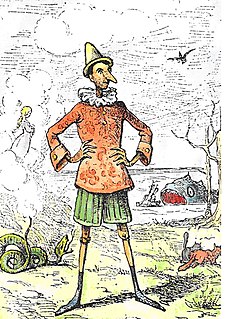
The Adventures of Pinocchio is a children's fantasy novel by an Italian author Carlo Collodi, written in Pescia. It is about the mischievous adventures of an animated marionette named Pinocchio and his father, a poor woodcarver named Geppetto.

Pinocchio is a 1940 American animated musical fantasy film produced by Walt Disney Productions and based on the 1883 Italian children's novel The Adventures of Pinocchio by Carlo Collodi. It was the second animated feature film produced by Disney, made after the first animated success Snow White and the Seven Dwarfs (1937).
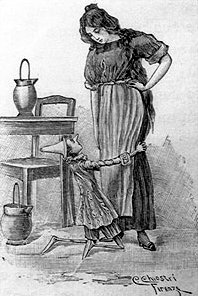
The Fairy with Turquoise Hair is a fictional character in the 1883 Italian book The Adventures of Pinocchio by Carlo Collodi, repeatedly appearing at critical moments in Pinocchio's wanderings to admonish the little wooden puppet to avoid bad or risky behavior.

The Adventures of Pinocchio is a 1996 fantasy family film, directed by Steve Barron and based on the original 1883 novel of the same name by Carlo Collodi. Barron collaborated with Sherry Mills, Tom Bender and Barry Berman on the screenplay. The film was an American, British, French, Czech, and German venture produced by New Line Cinema, The Kushner-Locke Company, Savoy Pictures, Pangaea Holdings and Twin Continental Films. The film stars Martin Landau, Jonathan Taylor Thomas, Rob Schneider, Udo Kier, Bebe Neuwirth, David Doyle and Geneviève Bujold. The film was both a critical and commercial failure.
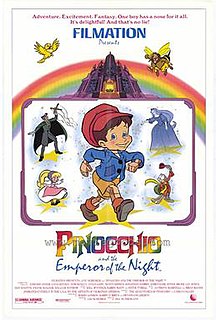
Pinocchio and the Emperor of the Night is a 1987 American animated fantasy adventure film that was released on December 25, 1987, by New World Pictures. Created by Filmation, the film was conceived as a sequel to the 1883 Italian classic novel The Adventures of Pinocchio by Carlo Collodi, being set a year after Pinocchio became a real boy. It was also described by some as a "thinly-veiled" sequel to Disney's 1940 classic Pinocchio. Disney sued Filmation for copyright infringement, but Filmation won the lawsuit on the grounds that Collodi's work is in the public domain.
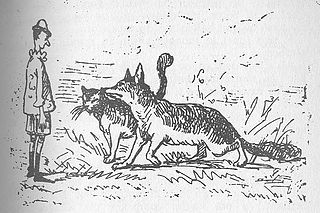
The Fox and the Cat are a pair of fictional characters and the main antagonists, along with the Terrible Dogfish, in Italian writer Carlo Collodi's 1883 book Le avventure di Pinocchio. They are depicted as poor con-men, who hoodwink Pinocchio and attempt to murder him. They pretend to be disabled: the Fox lame and the Cat blind. The Fox appears to be more intelligent than the Cat, who usually limits himself to repeating the Fox's words.
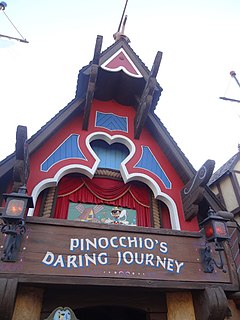
Pinocchio's Daring Journey is a dark ride at Disneyland in California, Tokyo Disneyland, and Disneyland Park in Paris. Located in the Fantasyland section of each park, this ride is based on Disney's 1940 animated film version of the classic story, which was the studio's second animated feature film. The attraction tells an abbreviated version of the film, with Pinocchio escaping from Stromboli's puppet show and visiting Pleasure Island, ignoring Jiminy Cricket's advice. Monstro the whale makes an appearance, and Pinocchio is finally reunited with Geppetto and turned into a real boy.

Mangiafuoco is a fictional character who appears in Carlo Collodi's 1883 Italian book The Adventures of Pinocchio. He is the theatre director and puppet-master of the Great Marionette Theatre, portrayed as gruff and imposing, but capable of showing kindness and easily moved to compassion, which he expresses by sneezing: after initially wanting Pinocchio to be burned as firewood for ruining one of his puppet shows, he eventually sets him him free and gives him five gold coins for his father Geppetto.
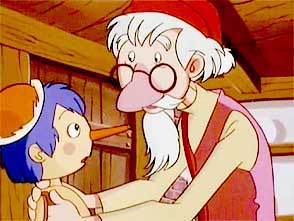
Pinocchio: The Series, also known as Saban's The Adventures of Pinocchio and known in Japan as Mock of the Oak Tree in Japan, is a 52-episode anime series by Tatsunoko Productions first aired on Fuji Television in 1972, which was edited by Saban in 1990. The story is based on the 1883 novel The Adventures of Pinocchio by Italian author Carlo Collodi.

The Coachman, also known as The Little Man (L'Omino), is a fictional character who appears in Carlo Collodi's 1883 book The Adventures of Pinocchio.

The Terrible Dogfish is a dogfish-like sea monster, which appears in Carlo Collodi's 1883 book The Adventures of Pinocchio as one of the main antagonists and the final one. It is described as being larger than a five-story building, a kilometer long and sporting three rows of teeth in a mouth that can easily accommodate a train. So fearsome is its reputation, that in Chapter XXXIV, it is revealed that the Dogfish is nicknamed "The Attila of fish and fishermen".

The Land of Toys is a fictional location in the Italian novel The Adventures of Pinocchio (1883) that is disguised as a haven of freedom and anarchy for boys and occasionally girls, but is eventually discovered to be far more sinister.

Geppetto, also known as Mister Geppetto, is an Italian fictional character in the 1883 novel The Adventures of Pinocchio by Carlo Collodi. Geppetto is an elderly, impoverished woodcarver and the creator of Pinocchio. He wears a yellow wig resembling cornmeal mush, and consequently his neighbors call him "Polendina" to annoy him. The name Geppetto is a Tuscan diminutive of the name Giuseppe.
The Adventures of Pinocchio is a 2007 opera in two acts by Jonathan Dove with a libretto by Alasdair Middleton based on the 1883 Italian novel of the same name by Carlo Collodi. It tells of the creation of the wooden puppet Pinocchio and some of his adventures on the way to becoming a real boy.

Pinocchio is an Italian fictional character and the protagonist of the children's novel The Adventures of Pinocchio (1883) by Italian writer Carlo Collodi of Florence, Tuscany. Pinocchio was carved by a woodcarver named Geppetto in a Tuscan village. He was created as a wooden puppet but he dreams of becoming a real boy. He is known for his long nose, which grows when he lies.

The Adventures of Pinocchio is a 1972 Italian animated fantasy film produced by Cartoons Cinematografica Italiana. An adaptation of Carlo Collodi's 1883 book The Adventures of Pinocchio, it is written, produced, directed and edited by Giuliano Cenci. The English dub, narrated by Victor Jory, was released in the United States by G.G. Communications in 1978.
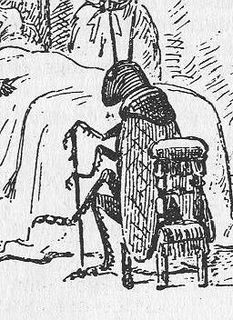
The Talking Cricket is a fictional character that appears in the 1883 Italian book The Adventures of Pinocchio by Carlo Collodi.

Candlewick is a fictional character who appears in Carlo Collodi's 1883 book The Adventures of Pinocchio.

The Adventures of Pinocchio is a 1972 Italian five-part miniseries directed by Luigi Comencini, which originally aired weekly on Rai 1 between April 8 and May 6, 1972. Based on Carlo Collodi's 1883 novel with the same name, the miniseries received a large critical success, and had an average of twenty-one and a half million viewers during its first airing. All the episodes together make up 280 minutes of runtime.

The Adventures of Pinocchio is a 1911 Italian live-action silent film directed by Giulio Antamoro and starring Ferdinand Guillaume.


















